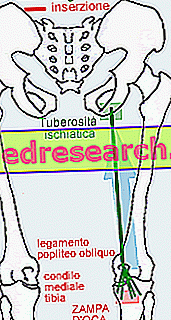
What is buckwheat
Buckwheat ( Polygonum fagopyrum ), also known as black wheat, is an annual herbaceous plant belonging to the Polygonaceae family.

Because of its nutritional properties, and its remarkable food uses, buckwheat is often classified as a cereal, although it does not belong to the Gramineae family.
Plant
The buckwheat plant has a not very developed root system. The stem is free of hair (glabrous), cylindrical and with a color that varies according to the state of maturation of the plant: initially it appears green, but with the passage of time - as the mature plant - becomes red- brownish.
At the end of each branch we note the presence of an inflorescence, whose color can be white or pink depending on the variety collected.

The harvest of buckwheat fruits occurs when they have reached a dark color. The harvesting process must be preceded by the drying process, for a period ranging from 10 to 20 days.
The buckwheat plant recognizes its natural habitat in areas where the climate is not particularly cold, and where the environmental temperature is around 20 ° C. He is very afraid of temperature changes and water shortages; for this reason it carries out its life cycle entirely during spring and summer. The buckwheat plant prefers not very fertilized soils with an acid pH.
History
Buckwheat has very ancient origins. Its cultivation begins in the areas of Siberia, Manchuria and China. Over time, buckwheat also begins to be grown in Japan, India and Turkey. In Italy it arrives in the fifteenth century, thanks to maritime trade across the Black Sea, and only after the Middle Ages did it acquire a distribution and cultivation worthy of note also at European level.
Buckwheat is still widely used in traditional cooking; in fact it is included in many world recipes and in the Italian culinary tradition. For example, buckwheat is used in mountain cuisine as a basic ingredient for the production of "polenta taragna", "pizzoccheri Valtellina" and "sciatt", typical sweets of the Valtellina.
Valtellina's pizzoccheri
Buckwheat flour is the main ingredient of this recipe, explained by our PersonalCooker Alice in the kitchen of the wonders of MypersonaltrainerTv.
pizzoccheri
X Problems with video playback? Reload from YouTube Go to Video Page Go to Video Recipes Section Watch the video on youtubeNutritional characteristics
Buckwheat has all the nutritional characteristics of a cereal and a legume, even though, from the botanical point of view, neither one (does not belong to the Gramineae family) nor the other (it does not belong to the Leguminosae or Fabaceae family) .
Buckwheat seed is mainly composed of starch, 25% amylose and 75% amylopectin, respectively. The abundant presence of the latter makes it easily digestible.
The proteins contained in the buckwheat seed have a good biological value. They are in fact composed both of essential amino acids, such as lysine, threonine and tryptophan, and of sulfur-containing amino acids.
Buckwheat has no gluten in its protein composition; this means that it can be used in all gluten-free foods suitable for people with celiac disease.
The lipids present in buckwheat are composed of both saturated fatty acids (from 8 to 18 carbon atoms), and from mono (16: 1, 18: 1, 22: 1) and polyunsaturated (18: 2 and 18: 3) .
Buckwheat is rich in mineral salts such as iron, phosphorus, copper, zinc, selenium and potassium. The latter even exceeds the quota contained in the other cereals. A precious component, both of the seed and of the vegetable part, is represented by antioxidants.
The vitamins contained in buckwheat are mainly B1, B2, niacin (PP) and B5.
To learn more about the nutritional value of buckwheat click here.
Among the antioxidants present, we remember rutin and tannins, more concentrated in the herbaceous part, therefore in the leaf.
Rutin is a glycoside of quercetin, which has the strength of the capillary wall as a health benefit. Rutin-based products can therefore prevent the appearance of bleeding, improving the microcirculation and exhibiting a marked anti-inflammatory and antioxidant properties. In addition to the presence of rutin, buckwheat contains other flavonoids, such as vitexina, isovitexina, isorientina and quercetin.
Buckwheat, thanks to its ability to provide energy and "vigor", can be introduced into the diet for athletes, pregnant women and the elderly. Furthermore, as mentioned, it can also be taken by people with celiac disease
Always remaining in the food industry, buckwheat has a flaw, which is to be a potential allergen. Food allergies towards this cereal are concentrated mainly in Asia, but recently they have also appeared in Italy.
The uses of buckwheat
Some scholars have carried out research on buckwheat proteins, detecting a particular affinity to cholesterol that would significantly reduce intestinal absorption. Other laboratory tests are evaluating the use of buckwheat as an adjuvant product against rheumatic diseases. In addition, buckwheat has galactogogic activity, so it would be very useful for breastfeeding mothers.
In the veterinary field, buckwheat can be used as forage. An abundant consumption can however cause the so-called buckwheat intoxication or phagopirism. The symptoms of this intoxication appear on the animal only after exposure to sunlight. Once exposed to the sun, you may notice a reddening of the parts without hair, such as the udders, the eyelids, the ears and the lips. The redness can also be accompanied by the appearance of blisters and dark-colored crusts, while in more serious cases buckwheat poisoning can produce a bacterial infection followed by necrosis.



